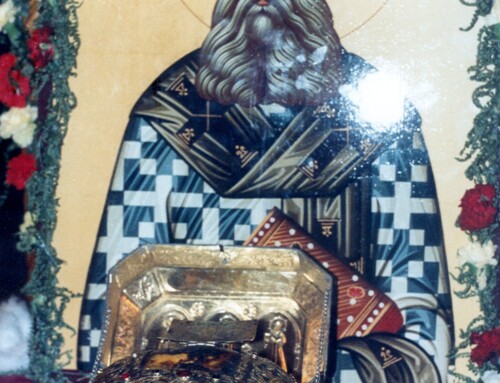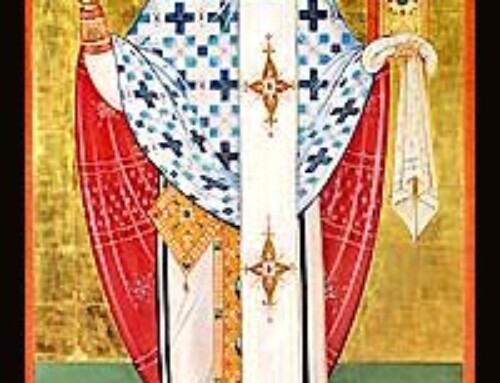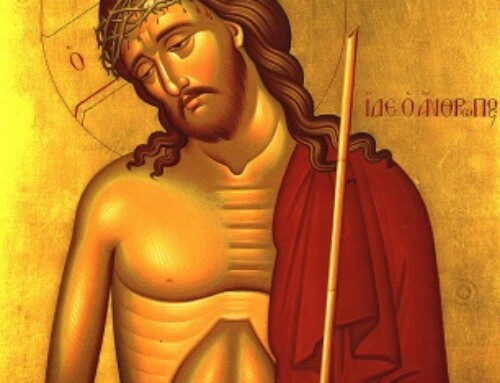Word Magazine November 1990 Page 5-7
THE GRIEF THAT HEALS
by Father Joseph Allen
This brief commentary on grief is a combination of things. It is, at once, something experienced and something learned, something lived and something academic. It is a commentary which seeks to demonstrate that only when one grieves properly, is healing possible. Hence the title, “The Grief That Heals.”
For those who know me, it will be no surprise that I write this article. I teach pastoral ministry — some call it practiki, practical theology — that forum where theology intersects with life.
In 1989 my wife Joan died. In 1990 I taught a course at St. Vladimir’s Seminary entitled Thanatology, from the word Thanatos, death. In simple English terms it means the study of death, dying and bereavement. The reader should know that I have taught this course before. But never did I teach it like this, I say that because, strangely, my experience verified the academic theories, and whenever life itself can say “yes” to any theory, those of us in academia rejoice. In line with this, although at first I wanted to avoid teaching that class, now I am extremely thankful that I did.
But the basis used for writing this commentary is not strange to any study in this area of pastoral ministry; the materials which should be assigned to the students should always attempt to reflect this combination of the experiential and the academic. For this particular class, Tolstoy’s Ivan Illych and CS. Lewis’ A Grief Observed combine with the more academic and theological work of Sullender’s Grief and Growth. I shall refer to these same sources in this brief commentary.
Using the double orientation, then, I hope to share three fundamental questions, each a crucial one for people of faith: 1) What is grief? 2) What happens when one grieves? and 3) What should we do for others in their grief?
What is Grief?
Grief is a process and therefore it is always changing and becoming; it is never a fixed commodity. The literature in the thanatological studies is clear that the manifestation of grief varies as greatly as individual persons vary. It does show that there are different “stages” within this process, but that individuals pass through these stages differently. It is also revealed that certain “cultural factors” play heavily in how persons grieve.
But despite these varying factors, it is always true that grief is directly proportional to the type of loss which the griever experiences. For example, without explicating too much in “clinical” terms, the loss of an uncle or aunt that one has not seen for many years is very different than that of a parent. Or again, the studies have shown a very different grieving response to the loss of a spouse when compared with the loss of a child. The point here, however, is that grief is the human emotional response to loss, but that that loss is experienced in a variety of ways and intensities.
So far one will have no difficulty in understanding such an obvious point; both the academic literature and human experience validate this truth.
But there are other factors which make grief and grieving more difficult to both understand and experience.
For example, there is the phenomenon known as “separation anxiety.” This results from the acute fear within the self over that which is lost. But it does not have to do with love. In fact, this is what Sullender means when he says, “grief is related to attachment, not to love.” (p. 31). That is the first issue: there is in the griever the strong impulse to “hold on” to what surrounds him or her; this may even take physical shape. Thus Sullender writes: “grief is caused not by the loss of a loved one, but by the valuing process of the griever. Grief exists because the griever gave meaning to that which is lost. In short, grief is a function of attachment.” (p. 32).
This means that the first issue of this grieving process moves from the loss (which is difficult enough), to the problem of attachment (which is a much more complicated psychological problem):
On the behavioral level people form habits, routines, accustomed ways of doing things. . . Losses are events which rupture these structures. Suddenly all the old attachments, old ideas and routines are disrupted. Structure is replaced by chaos. The essence of grief is a striving to restructure life . . . to put life ‘back together’ (Sullender, p. 66).
This can happen no matter how much or how little — love was felt for the person who was lost.
The second issue in the grieving process is that when it is spiritually healthy, it leads somewhere, i.e., it moves from a certain stage to another. Again without too much clinical explication, C.S. Lewis captures this meaning when he remembers that his mourning was a process — not a “state” — in which, “when remembered H. least, he remembered her best” (p. 57). Again, this does not mean that Lewis did not love H.; quite the contrary. Rather, this refers to the mode in which that memory worked. Sidney Jourard sees this same concept of the grief process as a “journey” in which one leaves home for a new land, and returns an “enlarged self.” In other words, this journey represents the healing process which a proper grieving delivers. On the more academic side, Sullender explains the destination of that journey when he purports that “successful grief work means that one can remember without mourning.” This means that one does not have to forget in order to be healed, in order to move on in life. As we will see, with a proper faith in God, this journey will lead to a healing in which one’s memory will work, but now in the light of a vivifying hope, one which transforms a person’s vision from acute pain to newness of life. Because in life, there is always darkness and light, the spiritual question can be properly asked: what are we looking for? or rather, what are we looking to? Is this not what St. Paul meant when he said we are to grieve, but not as those who have no hope? (I Thess. 4:13).
What Happens When One Grieves?
After our brief look at “what is grief;’ we must then ask, “but what happens when one grieves?”
In a sense, we have already begun to answer this question. But with this question, one now fully engages the “faith issue” itself. After all, the theology which informs our particular concern is a theology of hope, one which teaches that each of us is called to transcend our attachments, and to love in spite of our inevitable losses. But these conditions are rooted in Christian hope. But Ivan Illych and CS. Lewis experientially find this answer of faith at the end of their grief process, a process which in fact Sullender states, “allows a bereaved person to love again.” Here we learn wherein lies our only hope: the Giver of life.
As we learn in the Epistle of James (1:17), and at every Eucharistic Liturgy one is called to be thankful to God for every gift — and each loved being is one such gift — but one is never to confuse the Giver of the gift with the gift itself. This is the final antidote to a wrong “attachment.” Ann Loades, when referring to how C.S. Lewis was healed by his grieving remarks: “The key to this recovery was praise as a mode of loving, of God as Giver, and her as a gift.” In the same way when Ivan Illych saw “light” at the very end of his own life, it was because he finally discovered that his hope was not in those various gifts which populated his life. Rather he now understood them as the “insubstantiality of his manner of life, values adhered to by society and his profession” (p. 127).
This ultimate clarification came when his son kissed his hand, and he then “fell through and saw light.” This even led to his need to forgive the others before accepting his own death. But for our present purposes, the point is that the “light” — the illumination — will always lead beyond the gift to the Giver Himself; He is our only hope. (Psalm 39:7). No one of faith in God has the right to remain “attached” to the gift, even when its loss brings such pain. Hope teaches this lesson.
But this same clarification about hope, in turn, also teaches us about spiritual growth. Lewis makes this particular point, already known to any person who has not only studied theology, but experienced theology: “one must be knocked silly to come to his senses. Only torture will bring out this truth. Only under torture does he discover it himself” (p. 50). Then — and only then —does Lewis recount his “enormous gain” when he turns to God, i.e., after his grieving “unlocks the door” Sullender, in his theoretical orientation, explains how persons experience such growth through loss, and thus, also experience the “value change:’ This spiritual growth occurs when the loss “clarifies faith, builds maturity, and strengthens the belief and understanding of God.” All this leads to a transformation of the self which can only, in turn, engender a deeper communion of love.
Of course, we can do nothing about the loss. It is painful, and it is not to be looked for; it is divisive and evil. Christians are not to be masochists. But sometimes, there it is — right before us, entering our life like the wound of a sword. The proper grief, however, is what the one of faith will do about it! Should one who is thus wounded merely return to where he or she was before the loss? to the status quo ante? Sullender makes this point, one which is certainly verified by the personal experience of any Christian person:
When people suffer a severe loss, they are wounded. Grief is the process of healing that wound. When the grief process is completed, people say of the bereaved that they have “recovered,” “been restored,” . . . is “his or her old self again.” But many grievers are not “just recovered” in the sense of being the way they were before the loss. On the contrary they have grown in the process of being healed. There are unmistakable new elements in their life — new skills, new attitudes, new relationships, new insights. They are “new” people. (Sullender, p. 67).
This truth, however, i.e., that grief can lead to growth, is shrouded in the secret everyone in our modern world wants to keep from the light of reality: everybody suffers and that suffering, if met by an antecedent faith, can lead to growth. The truth, then, is that since there is no growth without pain, one must learn to move through it, rather than to avoid it. This is the Cross which must be borne before the Resurrection can be realized.
Besides spiritual growth, there are also issues of time and orientation. We have already said that grievers are healed when they can remember clearly that which is lost, but now without the intense pain. They are at peace with the past, and now live with the hope which is given by God’s grace. In the everyday occurrences of life, this hope translates into the quality of a future orientation. Sullender captures this as he reminds us that with hope in God, such grievers are able to invest themselves again into new challenges, new dreams and new commitments.
The simple passage of time alone does not heal wounds — either physical or emotional. A healthy environment helps the process. Time alone will not heal, but what one does with time can. The key criterion for a healing environment is an attitude of acceptance and openness to human feelings and human pain. (Sullender, p.60).
Sullender’s point is that people who are comfortable with their own interior feelings are “natural grievers.” In turn, he claims that those who are uncomfortable with their own feelings will grieve only with great anguish, pain and resistance, (p. 62). Both the experiential and academic verify this truth.
These three, then, help to answer our second question — “What happens when one grieves?” It is the “faith issue” which holds together these three healing components: hope, growth and future orientation.
What Should We Do for Others?
To understand what grief is, then what happens when one grieves, is not enough. We must also be “carers,” persons who love enough to ask what we should do for others who grieve.
To begin with, one can never help another to grieve if he or she does not love. For Christians, love is a requirement; it is not arbitrary, nor merely something which we “fall into.” In our particular case, this love-as-care is true for both laity and clergy since both share in the pastoral ministry of the Church. But also this is risky business, to be sure, one in which a person is unprotected and vulnerable. That’s the way true love is: lovers always run the risk of being wounded.
Sullender writes correctly that “we should be clear about this: grief is an inevitable part of love. The more we ask parishioners ‘to care,’ the more we are asking them to be willing to grieve. One cannot truly care without being hurt” (p. 35). He follows this point with a reminder, now specifically aimed at the clergy:
If we wish people to be ‘lovers’ and ‘caregivers,’ then we as pastors must help them learn how to grieve. If our style of ministry tends to deny, avoid or repress grief feelings, then we will repress love as well. We can teach our parish how to love when we teach them how to grieve (p. 36).
In truth, the grieving person must be led into such an understanding, one which is rooted in God as a “fellow sufferer.” After all, we have to be taught that He is the one who entered fully into our world, and therefore knows intimately the pain and suffering of all living beings. This God, who is Himself the “wounded healer,” is the God of the Incarnation, the Manger, and the Cross; He is the champion of the meek, the poor and the bereaved. In terms of our present concern, this means that loss and bereavement is always a new opportunity for each of us to reintroduce this meaning, first into the griever’s mind and heart, and therefore into our own.
This understanding, i.e., that God really is a “fellow sufferer,” leads a person into a basic trust in God, one which breaks out into a future “beyond despair.” Sullender emphasizes the point that a part of the grieving process is a leaving behind of the past and an entering into the future:
What makes that future possible? I believe it is a basic trust, a faith in the future, and by implication, the One who is there. The fear of the unknown is frightening, but faith is trusting that the future can be good . . . Faith is trusting that the future belongs to God, and that God is already there, working to bring new life out of the old, (p. 212).
“What we should do for others,” then, is reflected first of all in our willingness to enter with them into “the valley of the shadow of death” to enter with them into “the pit” — for, in this case, such is the meaning of love. But that same love teaches us never to stay there, and never to be satisfied with another’s desire to stay there. The grieving person may express anger, fear, guilt, depression, (and each of these one will find in the thanatological literature which is assigned to the students in the Thanatology class). From an experiential perspective, I can absolutely vouch for the presence of such phenomena. But if hope is “the anchor of the soul” (Hebrews 6:19) — and it certainly is —then one who clings to that anchor, will be led out of such negative emotions, and into a deeper spiritual life.
I would like to end my rather “staccato” exposition with a very simple truth. Despite what I have discovered in either the academic literature for my course in Thanatology, or in my own personal experience of grief, I know now that it was precisely a certain atmosphere which led to healing: it was God’s community, celebrated in the Eucharist, practiced in the everyday life of the parish, enlivened in the communion of love, not really of “parishioners,” but of veritable brothers and sisters in the Lord — these are the elements of care through which God’s grace has flowed into my life, and thus, which have healed me.
And to return to my original statement: it is from this same environment of healing that I have truly learned what I now know in terms of what is grief, what happens when one grieves, and what we should do for others in their grief.
And now I look for the light.
Father Joseph is the Vicar General of the Archdiocese and Adjunct Professor of Pastoral Theology at St. Vladimir’s Seminary. This is the first in a series of three articles, the other two being “Grace” and “Hope”.





